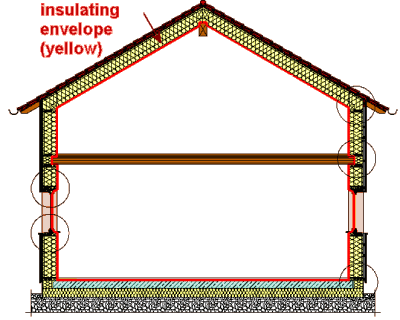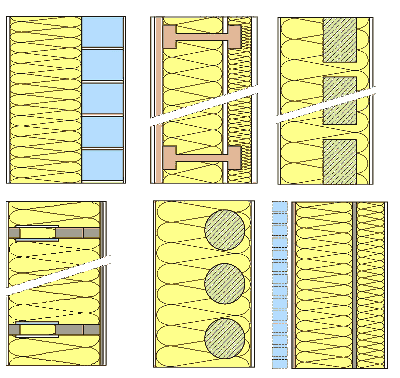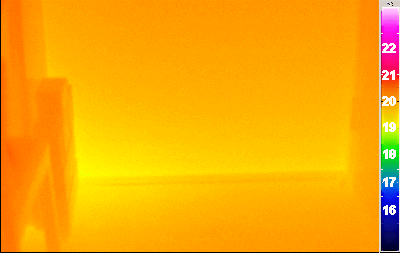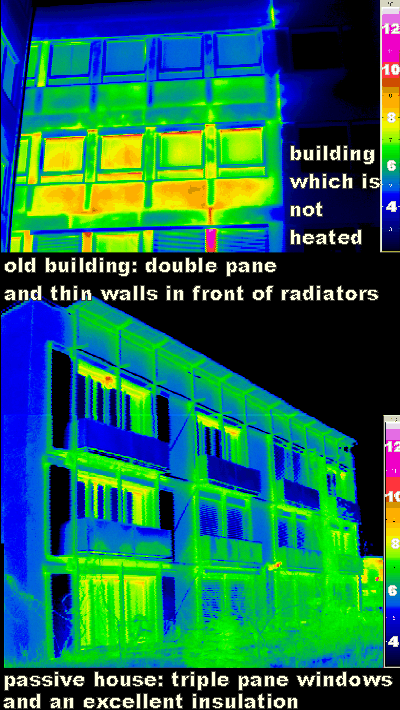| |
Thermal
Insulation of Passive Houses |
|
|
Infrared
picture of the joint between the basement floor an the external
wall in a passive home (taken from the inside). There are no "cold
spots" (photo: PHI).
|
| A key feature of a passive house
is that they incorporate very high standards of insulation. This
reduces the amount of heat lost through the building fabric to a
very low level. When achieving these very high standards of insulation
the purpose provided heating requirement, even on the coldest days,
is reduced to a minimum and hence it is possible to adequately heat
the dwelling by just preheating the fresh air entering the rooms.
The heat loss through a regular
construction (an external wall, a floor to the basement or a slab
on ground, a ceiling or a roof) is characterised by the thermal
heat loss coefficient or U-value. This value shows, how much heat
(in Watts) is lost per m2 at a
standard temperature difference of 1 degree Kelvin. The international
unit of the U-value therefore is “W/(m²K)”. To calculate
the heat loss of a wall you multiply the U-value by the area and
the temperature difference. The following table presents the
typical heat
losses for different external walls based on a typical European
single family house with an external wall area of 100 m². Winter
temperatures of -12 °C outside and 21 °C at the inside
are used as they are typical of Central Europe. U-value heat
loss annual
annual costs (2005) A typical compact services unit for a passive house will typically deliver ~1000 W without a problem. For the compact service unit to meet the total heat loss (floor, windows, doors, roof in addition to the external walls) the U-value of the wall has to be really low, suitable are values in the range between 0.1 to 0.15 W/(m²K).This means that the heating requirement matches the output of the compact services unit. Ho does this translate into the construction of the building envelope? First it is obvious that U-values that low only can be achieved using really good insulating materials. The following table shows the thickness needed of an exterior construction, if that is solely built from the material given, to meet a typical passive house U-value of 0,13 W/(m²K):
The construction thickness will
be less, the lower the heat conductivity of the insulating material
is. A straw bale construction of typical thickness (50 cm and more)
does already meet the requirements for a passive house. Using typical
conventional insulating materials (mineral wool, polystyrene, cellulose)
the thickness needed is some 300 mm. This can be reduced to 200
mm by using polyurethane foam, which is more expensive, however.
In Germany vacuum insulation materials have been used in the building
industry in some cases. Another approach already used with success is a construction with a "semi-translucent envelope": In doing so the global radiation is allowed to be absorbed somewhere deeper in the construction, this leads to a reduction of the temperature difference and therefore in a lower equivalent U-value. Be careful with this approach in hot climates - while the classical insulation approach is working quite well against heat loads in hot periods, the semi-translucent insulation will heat up even more. What about economy? It is a wide spread believe, that super insulation, like it is used passive houses, does not pay back. Let us check that again! Please glance at the table provided. In the third column the total heat losses of one year per m² of the construction area are given. It is quite simple to calculate those: you multiply the U-value by the average temperature difference and the time interval of the heating period; or, even simpler, just U-value times heating degree hours - in a Central European climate 78000 degree hours. For producing the heat natural gas, heating oil, district heating or electricity is used - it will not be possible to buy the heat for less than 5,5 €Cent per kWh nowadays and the future energy price wont be lower on average. Therefore the annual costs for heating just to substitute the losses of the external wall (100 m²) will be as high as given in the last column. See a section of the table here: U-value
heat loss- annual annual
heating In the first row (red) the values for a typical external wall of an old building are given, not the less insulated one. Some 536 € have to be payed every year just to compensate the heat losses through 100 m² of this wall. With an additional insulation of a quality used in passive houses (green) the heat loss is reduced by a factor 10. The annual costs of the energy loss now are lower than 54 €/a. That means: 482 €/a cost reduction for heating. What has to be done to achieve at this energy saving? This is, what we recommend: To wait, until the external wall need a new plaster or a new painting anyhow - that can not last too long, unless it has just been done. Then the costs for the scaffold and the new facade painting have to be payed anyhow, that ammounts to some 2500 €. Now ask your credit institute for the volume of a hypothecary credit to be payed back by a annual rate of 480 €/a for interest and redemption over 20 years. This credit will ammount to some 6300 € taking contempory conditions into account. Together with the 2500 € anyhow-retrofit costs it is 8800 € now for the measures to be taking at the external surface of this wall. There is no question that one can get a top super insulation by spending this money. And, for a new construction, it will be even more attractive. Do you think that just sounds like a zero-sum game? To spend all the money saved just for handycrafts work? Well, it is not the whole truth:
Conclusion:
It is attractive. The right desicion is "whensoever, take the
best insulation available" . Lots of the insulation technologis will be demonstrated at the exhibition taking place during the 11th international conference on passive houses. Experience The experience during construction of passive houses has shown, that the high insulation thickness can be realised with conventional insulation materials without any problem:
Super insulating components, like those beeing used in passive houses, have important advantages compared to poor or mediocre insulated building envelopes.
Latest research results and experiences with highly insulating constructions will be presented in workshop 4 of the 11th International Conference an Passive Houses. Complete examples of building elements for passive houses will be presented at the exhibition in Bregenz. One will find:
(updated: 2006-09-23
Author: Wolfgang Feist; thanks to Gavin Hodgson (BRE Ltd UK)
for proof reading the translation of the 1st edition
|




